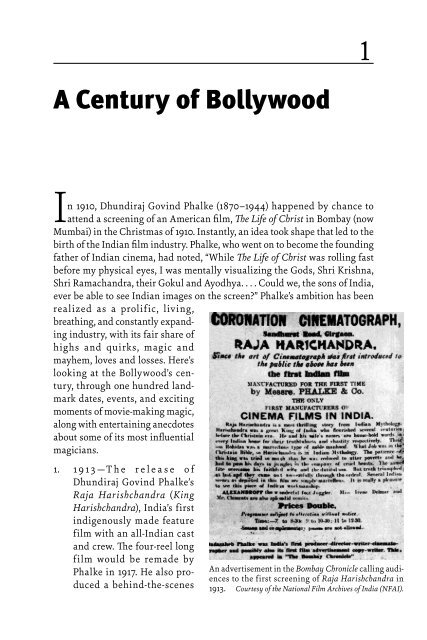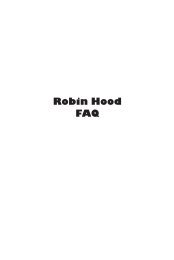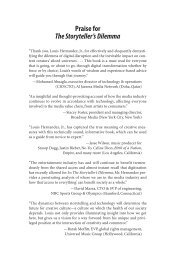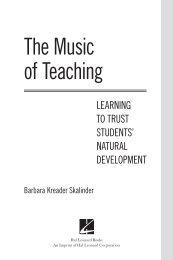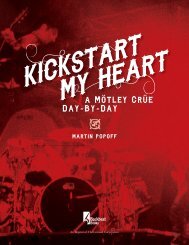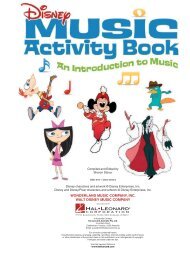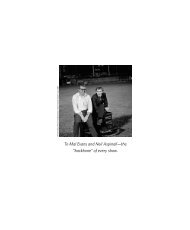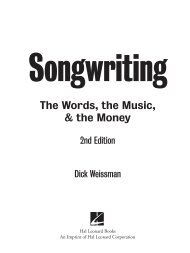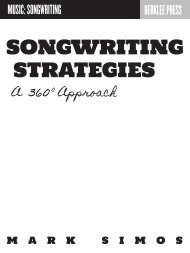- Page 1: Bollywood FAQ
- Page 4 and 5: Published by Applause Theatre & Cin
- Page 7 and 8: Contents Acknowledgments Introducti
- Page 9 and 10: Acknowledgments I have often been a
- Page 11: Acknowledgments xi Robert Lecker, o
- Page 14 and 15: xiv Introduction films. The Indian
- Page 17: Section 1 History and Highlights
- Page 21 and 22: A Century of Bollywood 5 5. 1925—
- Page 23 and 24: A Century of Bollywood 7 Devika Ran
- Page 25 and 26: A Century of Bollywood 9 and an inf
- Page 27 and 28: A Century of Bollywood 11 pre-song
- Page 29 and 30: A Century of Bollywood 13 Portraits
- Page 31 and 32: A Century of Bollywood 15 to hit th
- Page 33 and 34: A Century of Bollywood 17 57. 1978
- Page 35 and 36: A Century of Bollywood 19 actors An
- Page 37 and 38: A Century of Bollywood 21 81. 1998
- Page 39 and 40: A Century of Bollywood 23 92. 2009
- Page 41 and 42: Dadasaheb Phalke and the Birth of I
- Page 43 and 44: Dadasaheb Phalke and the Birth of I
- Page 45 and 46: Dadasaheb Phalke and the Birth of I
- Page 47 and 48: Dadasaheb Phalke and the Birth of I
- Page 49 and 50: Dadasaheb Phalke and the Birth of I
- Page 51 and 52: The Rise of Bombay Cinema 35 On the
- Page 53 and 54: The Rise of Bombay Cinema 37 V. Sha
- Page 55 and 56: The Rise of Bombay Cinema 39 spoken
- Page 57 and 58: The Rise of Bombay Cinema 41 Anothe
- Page 59 and 60: The Rise of Bombay Cinema 43 Talkie
- Page 61 and 62: The Rise of Bombay Cinema 45 the ci
- Page 63 and 64: The Rise of Bombay Cinema 47 doubtf
- Page 65 and 66: The Rise of Bombay Cinema 49 Calcut
- Page 67 and 68: The Rise of Bombay Cinema 51 Bombay
- Page 69 and 70:
Breaking Ground 53 The first cinema
- Page 71 and 72:
Breaking Ground 55 1913—First Her
- Page 73 and 74:
Breaking Ground 57 1920—First For
- Page 75 and 76:
Breaking Ground 59 1929—First Lip
- Page 77 and 78:
Breaking Ground 61 three sons—Ran
- Page 79 and 80:
Breaking Ground 63 Zubeida Begum Dh
- Page 81 and 82:
Breaking Ground 65 1935—First Stu
- Page 83 and 84:
Breaking Ground 67 Cannes Film Fest
- Page 85 and 86:
Breaking Ground 69 her screen debut
- Page 87 and 88:
Breaking Ground 71 Bollywood gets i
- Page 89 and 90:
Breaking Ground 73 1960—First Fil
- Page 91 and 92:
Breaking Ground 75 1983—First Ind
- Page 93 and 94:
Breaking Ground 77 Nandita Das (lef
- Page 95 and 96:
Breaking Ground 79 2006—First Ind
- Page 97 and 98:
Breaking Ground 81 (Left to right)
- Page 99 and 100:
5 An Indian Way to Film Thinking .
- Page 101 and 102:
An Indian Way to Film Thinking . .
- Page 103 and 104:
An Indian Way to Film Thinking . .
- Page 105 and 106:
An Indian Way to Film Thinking . .
- Page 107 and 108:
An Indian Way to Film Thinking . .
- Page 109 and 110:
6 Music, Masala, and Melodrama An I
- Page 111 and 112:
Music, Masala, and Melodrama 95 A c
- Page 113 and 114:
Music, Masala, and Melodrama 97 wom
- Page 115 and 116:
Music, Masala, and Melodrama 99 Mus
- Page 117 and 118:
Music, Masala, and Melodrama 101 va
- Page 119 and 120:
Music, Masala, and Melodrama 103 st
- Page 121 and 122:
Music, Masala, and Melodrama 105 th
- Page 123 and 124:
Music, Masala, and Melodrama 107 Te
- Page 125 and 126:
Music, Masala, and Melodrama 109 so
- Page 127 and 128:
Trend-Spotting Down the Decades 111
- Page 129 and 130:
Trend-Spotting Down the Decades 113
- Page 131 and 132:
Trend-Spotting Down the Decades 115
- Page 133 and 134:
Trend-Spotting Down the Decades 117
- Page 135:
Trend-Spotting Down the Decades 119
- Page 139 and 140:
8 The First Lady of Indian Cinema Y
- Page 141 and 142:
The First Lady of Indian Cinema 125
- Page 143 and 144:
The First Lady of Indian Cinema 127
- Page 145 and 146:
The First Lady of Indian Cinema 129
- Page 147 and 148:
The “Fearless” Woman with the W
- Page 149 and 150:
The “Fearless” Woman with the W
- Page 151 and 152:
The “Fearless” Woman with the W
- Page 153 and 154:
The Thespian of Good Acting 137 Dil
- Page 155 and 156:
The Thespian of Good Acting 139 sta
- Page 157 and 158:
The Thespian of Good Acting 141 an
- Page 159 and 160:
A Masterclass in Villainy 11 Traini
- Page 161 and 162:
A Masterclass in Villainy 145 emoti
- Page 163 and 164:
A Masterclass in Villainy 147 I wou
- Page 165 and 166:
12 Bollywood’s Monroe (1933-1969)
- Page 167 and 168:
Bollywood’s Monroe 151 Kumar to t
- Page 169 and 170:
Bollywood’s Monroe 153 Madhubala,
- Page 171 and 172:
13 The Superstar Phenomenon The day
- Page 173 and 174:
The Superstar Phenomenon 157 fair-c
- Page 175 and 176:
The Superstar Phenomenon 159 The Fa
- Page 177 and 178:
Megastar of a Millennium 14 I am as
- Page 179 and 180:
Megastar of a Millennium 163 had co
- Page 181 and 182:
Megastar of a Millennium 165 A Few
- Page 183 and 184:
Megastar of a Millennium 167 eccent
- Page 185 and 186:
15 The King of Romance There are on
- Page 187 and 188:
The King of Romance 171 Nagar. He w
- Page 189 and 190:
The King of Romance 173 The Global
- Page 191 and 192:
The King of Romance 175 for his man
- Page 193 and 194:
The Game Changer 177 Actor-producer
- Page 195 and 196:
The Game Changer 179 these ten odd
- Page 197 and 198:
The Game Changer 181 Se Qayamat Tak
- Page 199 and 200:
The Game Changer 183 Farhan Akhtar,
- Page 201 and 202:
A Diva for All Seasons 185 “They
- Page 203 and 204:
A Diva for All Seasons 187 actress-
- Page 205 and 206:
A Diva for All Seasons 189 and the
- Page 207 and 208:
18 Crossover Stars The Bollywood Pr
- Page 209 and 210:
Crossover Stars 193 John Reno, Andy
- Page 211 and 212:
Crossover Stars 195 demonstrated he
- Page 213 and 214:
Crossover Stars 197 Boy. The film r
- Page 215 and 216:
Crossover Stars 199 An Actor for Al
- Page 217 and 218:
Crossover Stars 201 The “K” Fac
- Page 219 and 220:
19 Gossips, Scandals, and Grand Aff
- Page 221 and 222:
Gossips, Scandals, and Grand Affair
- Page 223 and 224:
Gossips, Scandals, and Grand Affair
- Page 225 and 226:
Gossips, Scandals, and Grand Affair
- Page 227 and 228:
Gossips, Scandals, and Grand Affair
- Page 229 and 230:
Gossips, Scandals, and Grand Affair
- Page 231 and 232:
Gossips, Scandals, and Grand Affair
- Page 233 and 234:
Gossips, Scandals, and Grand Affair
- Page 235:
Gossips, Scandals, and Grand Affair
- Page 239 and 240:
20 A Story About Song and Dance Why
- Page 241 and 242:
A Story About Song and Dance 225 En
- Page 243 and 244:
21 Lights, Camera, Music The Journe
- Page 245 and 246:
Lights, Camera, Music 229 Indian ci
- Page 247 and 248:
Lights, Camera, Music 231 distingui
- Page 249 and 250:
Lights, Camera, Music 233 their fir
- Page 251 and 252:
Lights, Camera, Music 235 At the re
- Page 253 and 254:
Lights, Camera, Music 237 Bhosle as
- Page 255 and 256:
Lights, Camera, Music 239 Melody ru
- Page 257 and 258:
22 Bollywood’s Greatest Music Alb
- Page 259 and 260:
Bollywood’s Greatest Music Albums
- Page 261 and 262:
Bollywood’s Greatest Music Albums
- Page 263 and 264:
Bollywood’s Greatest Music Albums
- Page 265 and 266:
23 Dancing Stars and Melody Czars H
- Page 267 and 268:
Dancing Stars and Melody Czars 251
- Page 269 and 270:
Dancing Stars and Melody Czars 253
- Page 271 and 272:
Dancing Stars and Melody Czars 255
- Page 273 and 274:
Dancing Stars and Melody Czars 257
- Page 275 and 276:
Dancing Stars and Melody Czars 259
- Page 277 and 278:
Dancing Stars and Melody Czars 261
- Page 279 and 280:
Dancing Stars and Melody Czars 263
- Page 281 and 282:
Dancing Stars and Melody Czars 265
- Page 283 and 284:
Dancing Stars and Melody Czars 267
- Page 285 and 286:
24 Singing Around the Globe Snowy A
- Page 287 and 288:
Singing Around the Globe 271 in the
- Page 289 and 290:
Singing Around the Globe 273 sequen
- Page 291 and 292:
25 Dancing in the Rain! The Indian
- Page 293 and 294:
Dancing in the Rain! 277 Jhangiani,
- Page 295 and 296:
Dancing in the Rain! 279 Raj Kapoor
- Page 297 and 298:
Dancing in the Rain! 281 Water is r
- Page 299:
Dancing in the Rain! 283 “Geela,
- Page 303 and 304:
26 The Auteurs The first Indian fea
- Page 305 and 306:
The Auteurs 289 have survived the t
- Page 307 and 308:
The Auteurs 291 Bimal Roy (1909-196
- Page 309 and 310:
The Auteurs 293 Yash Chopra (1932-2
- Page 311 and 312:
The Auteurs 295 Gulzar (b. 1934) Bo
- Page 313 and 314:
The Auteurs 297 Shyam Benegal. Aut
- Page 315 and 316:
The Auteurs 299 Kamal Amrohi (1918-
- Page 317 and 318:
The Auteurs 301 hinterlands and has
- Page 319 and 320:
Class Acts 303 Balraj Sahni as Sham
- Page 321 and 322:
Class Acts 305 Wow Moment Seemingly
- Page 323 and 324:
Class Acts 307 poet-director Gulzar
- Page 325 and 326:
Class Acts 309 Amjad Khan in Sholay
- Page 327 and 328:
Class Acts 311 Smita Patil in Bhumi
- Page 329 and 330:
Class Acts 313 role, when director
- Page 331 and 332:
Class Acts 315 Wow Moment The stand
- Page 333 and 334:
Class Acts 317 Wow Moment Silk’s
- Page 335 and 336:
28 101 Bollywood Movies and Songs t
- Page 337 and 338:
101 Bollywood Movies and Songs to S
- Page 339 and 340:
101 Bollywood Movies and Songs to S
- Page 341 and 342:
101 Bollywood Movies and Songs to S
- Page 343 and 344:
101 Bollywood Movies and Songs to S
- Page 345 and 346:
101 Bollywood Movies and Songs to S
- Page 347 and 348:
101 Bollywood Movies and Songs to S
- Page 349 and 350:
101 Bollywood Movies and Songs to S
- Page 351 and 352:
101 Bollywood Movies and Songs to S
- Page 353 and 354:
101 Bollywood Movies and Songs to S
- Page 355 and 356:
101 Bollywood Movies and Songs to S
- Page 357 and 358:
101 Bollywood Movies and Songs to S
- Page 359 and 360:
101 Bollywood Movies and Songs to S
- Page 361 and 362:
101 Bollywood Movies and Songs to S
- Page 363 and 364:
101 Bollywood Movies and Songs to S
- Page 365 and 366:
101 Bollywood Movies and Songs to S
- Page 367 and 368:
101 Bollywood Movies and Songs to S
- Page 369 and 370:
101 Bollywood Movies and Songs to S
- Page 371 and 372:
101 Bollywood Movies and Songs to S
- Page 373 and 374:
101 Bollywood Movies and Songs to S
- Page 375 and 376:
101 Bollywood Movies and Songs to S
- Page 377 and 378:
101 Bollywood Movies and Songs to S
- Page 379 and 380:
101 Bollywood Movies and Songs to S
- Page 381 and 382:
101 Bollywood Movies and Songs to S
- Page 383 and 384:
101 Bollywood Movies and Songs to S
- Page 385 and 386:
101 Bollywood Movies and Songs to S
- Page 387 and 388:
101 Bollywood Movies and Songs to S
- Page 389 and 390:
101 Bollywood Movies and Songs to S
- Page 391 and 392:
Bibliography Books A Board of Schol
- Page 393 and 394:
Bibliography 377 Schwartz, Susan L.
- Page 395 and 396:
Index 24 3 Idiots 1942—A Love Sto
- Page 397 and 398:
Index 381 Bazin, André Bbuddah . .
- Page 399 and 400:
Index 383 David, Joseph Dayavan Day
- Page 401 and 402:
Index 385 Howrah Bridge Hum Aapke H
- Page 403 and 404:
Index 387 Khan, Salim Khan, Salman
- Page 405 and 406:
Index 389 Menon, Rajeev Mera Naam J
- Page 407 and 408:
Index 391 Phool Khile Hain Gulshan
- Page 409 and 410:
Index 393 Saudagar Savkari Pash Sav
- Page 411:
Index 395 The Wrestlers Thirumugam,


